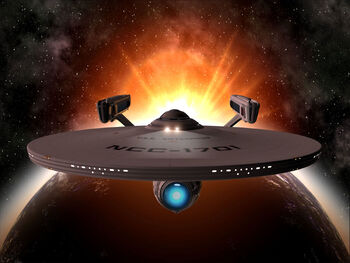Tag: Visual edit |
Tag: Visual edit |
||
| Line 97: | Line 97: | ||
== '''History''' == |
== '''History''' == |
||
[[File:CptRobertApril.jpg|thumb|168x168px|Robert April]] |
[[File:CptRobertApril.jpg|thumb|168x168px|Robert April]] |
||
| − | Designed and commissioned by Starfleet; the NCC-1700 and her sister starship, the NCC-1701 began construction in 2243. The various components were created at the San Francisco Naval Yards before shipped into orbit where they assembled under the oversight of Captain Robert April. |
+ | Designed and commissioned by Starfleet; the NCC-1700 and her sister starship, the NCC-1701 began construction in 2243. The various components were created at the San Francisco Naval Yards before being shipped into orbit where they were assembled under the oversight of Captain Robert April. |
April commandeered the as-of-yet unfinished and unnamed ship on a priority and unauthorized rescue mission near the Romulan Neutral Zone which was successfully completed thanks to the distinguished service of a security officer, George Kirk Sr. (and father of James T. Kirk). Subsequently, George Kirk would suggest to April that the unnamed ship to be named 'Enterprise'. In 2245 when the ship was completed; the NCC-1701 was christened the ''USS Enterprise ''while her sister ship, the NCC-1700 was designated the ''USS Constitution, ''becoming the lead ship of their starship class. |
April commandeered the as-of-yet unfinished and unnamed ship on a priority and unauthorized rescue mission near the Romulan Neutral Zone which was successfully completed thanks to the distinguished service of a security officer, George Kirk Sr. (and father of James T. Kirk). Subsequently, George Kirk would suggest to April that the unnamed ship to be named 'Enterprise'. In 2245 when the ship was completed; the NCC-1701 was christened the ''USS Enterprise ''while her sister ship, the NCC-1700 was designated the ''USS Constitution, ''becoming the lead ship of their starship class. |
||
| Line 105: | Line 105: | ||
Pike commanded the ''Enterprise'' from 2251 to 2262 and was responsible for heading two separate 5-year missions which saw distinguished scientific explorations in Rigel, Vega, and the Talos Systems. One of the most famous Starfleet officers, the half-human and half-Vulcan hybrid Spock served under Pike for 11 years, first as Science Officer before being promoted to his First Officer; a post he would continue under the next Captain of the ''Enterprise'' as well. |
Pike commanded the ''Enterprise'' from 2251 to 2262 and was responsible for heading two separate 5-year missions which saw distinguished scientific explorations in Rigel, Vega, and the Talos Systems. One of the most famous Starfleet officers, the half-human and half-Vulcan hybrid Spock served under Pike for 11 years, first as Science Officer before being promoted to his First Officer; a post he would continue under the next Captain of the ''Enterprise'' as well. |
||
[[File:Jameskirk.jpg|left|thumb|160x160px|James T. Kirk]] |
[[File:Jameskirk.jpg|left|thumb|160x160px|James T. Kirk]] |
||
| − | In 2264, James T. Kirk became the youngest Captain in the history of Starfleet and was simultaneously bestowed command of the already highly distinguished ''USS Enterprise.'' Kirk's legendary 5-year exploration cruise from 2265 to 2270 was also the most famous of the ''Enterprise's'' exploratory missions; setting new groundbreaking records of encounters with strange new life forms and new fantastic discoveries of alien civilizations. Even a century later, Kirk's 5-year mission logs remains required reading by aspiring Starfleet cadets. |
+ | In 2264, James T. Kirk became the youngest Captain in the history of Starfleet and was simultaneously bestowed command of the already highly distinguished ''USS Enterprise.'' Kirk's legendary 5-year exploration cruise from 2265 to 2270 was also the most famous of the ''Enterprise's'' exploratory missions; setting new groundbreaking records of encounters with strange new life forms and new fantastic discoveries of alien civilizations. Even a century later, Kirk's 5-year mission logs remains required reading by aspiring Starfleet cadets and his record of First Contact alien encounters was unmatched until Captain Kathryn Janeway of the ''USS Voyager'' was flung over 70,000 light years into the Delta Quadrant a century later. |
The'' Enteprise'' was the first Federation vessel to travel and survive an encounter with the Galactic Barrier; visited over seventy different worlds and made first contact with over sixty different alien races and species including the Gorn, the Horta, and the First Federation; encountered noncorporeal entities such as Trelane, the Thasians, the Organians, Gorgon, and the Zetarians; broke the Warp 9 Factor Barrier and time traveled on two separate occasions by accident; and encountered an alien entity that had once been worshiped on Earth as the Greek deity Apollo as well as the genetically augmented tyrant Khan Noonien Singh from the Eugenics Wars. |
The'' Enteprise'' was the first Federation vessel to travel and survive an encounter with the Galactic Barrier; visited over seventy different worlds and made first contact with over sixty different alien races and species including the Gorn, the Horta, and the First Federation; encountered noncorporeal entities such as Trelane, the Thasians, the Organians, Gorgon, and the Zetarians; broke the Warp 9 Factor Barrier and time traveled on two separate occasions by accident; and encountered an alien entity that had once been worshiped on Earth as the Greek deity Apollo as well as the genetically augmented tyrant Khan Noonien Singh from the Eugenics Wars. |
||
Revision as of 04:51, 22 December 2014
USS Enterprise (NCC-1701) is the central and most iconic starship from the Star Trek media franchise. The USS Enterprise serves as the main ship from the original series, the animated series, and first three Trek films.
Overview
The USS Enterprise, Naval Construction Contract (NCC) 1701 is a Constitution-Class Starship built in service for Starfleet and the United Federation of Planets in the 23rd Century.
Replacing the venerable NX-Class Cruisers, these starships were the trailblazers for Starfleet as the first true long duration exploration vessels for the fledgling organization. Capable of operating with minimal support for up to five years at a time; the Constitutions expanded the Federation's known space by via extended mapping and surveying thousands of cubic parsecs as well as making diplomatic contact with hundreds of alien species and races.
These heavy cruisers came to dominate the spaceways from the mid to late 23rd Century as the Federation's premiere multi-role starship capable of deep space exploration, scientific research, planetary defense and extended patrol missions. As a result of it's modularity of it's design, the Constitution-Class Starships enabled it to be upgraded for the next four decades, remaining at the cutting edge of Starfleet technology which led it to effectively became the standard vessel of Starfleet and inspiring over a century of future Federation starship designs.
The most famous and greatest of these vessels was the flagship of the fleet, the USS Enterprise.
Original Technical Specifications (2245; Star Trek: TOS and TAS)
- Overall Length: 288.6 meters (947 feet)
- Overall Beam: 127.1 meters (417 feet)
- Overall Draft: 72.6 meters (238 feet)
- Mass: 600,000 metric tons
- Displacement: 190,000 metric tons
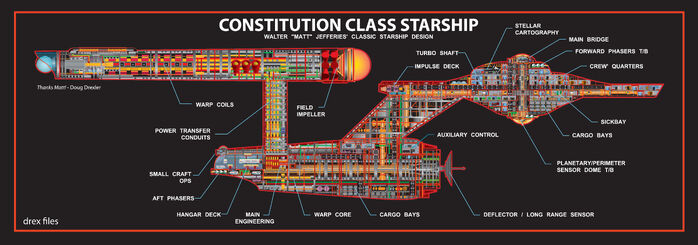
Enterprise Cutaway Diagram
- Decks: 21
- Crew Complement: 430 persons
- Cruising Speed: Warp 2
- Maximum Speed: Warp 6 (Warp 8 for short durations)
Refit Specifications (2272; Star Trek Movies)
- Overall Beam: 141.7 meters (465 feet)
- Overall Draft: 71.3 meters (234 feet)
- Mass: 620,000 metric tons
- Displacement: 210,000 metric tons
- Decks: 23
- Crew Complement: 432 persons
- Cruising Speed: Warp 8
- Maximum Speed: Warp 9
Design Features
The USS Enterprise was built to consist of two separate hulls; the saucer section (also known as the primary hull) and the engineering section (also known as the secondary hull).
The saucer section consisted of a roughly circular shape which contained the bridge module as well as the main living quarters for the officers and crew. Other facilities include gymnasiums, recreation areas, a small arboretum, the mess hall which incorporated food synthesizers that predated the replicators of the 24th Century, and sickbay which was roughly in the central section of the saucer and the most heavily protected areas. The saucer also contained the axillary control center which functioned as secondary bridge which could be used to operate the ship should the main bridge be damaged or destroyed.
Due to the heavy scientific and exploration nature of the Enterprise's missions; the saucer section boasted no less than 14 separate science labs. There was also a Security Section which included firing ranges, security cells or the 'brig', and the armory which contains hand held phaser weapons and phaser rifles and charging stations. The saucer section also included several transporter rooms which is a raised platform with special pads that can scan individuals on a quantum level, convert them into energy, then beam that energy up to 10,000 kilometers away and reassemble them. The transporters were the primary means for the crew to perform away missions on planet surfaces as the Enterprise was not designed for atmospheric landings. Instead, the ship would instead enter orbit and then beam down away teams. The transporters could not be used while moving at warp nor could it beam through energy shields.
The saucer section also contained the impulse drive deck; which propelled the Enterprise at sublight speeds (roughly a fraction of lightspeed) or as a intra-system drive. In emergencies, the impulse engines could also be used a back-up power source.
The engineering section was a tubular cigar-shaped section that is dedicated to the engineering and support systems of the Enterprise. This section included the matter/anti-matter reactor core and its assorted support equipment such as the anti-matter storage pods. The engineering section was also attached to the two main warp nacelles on elongated pylons. When fed by the power of the reactor core, the warp nacelles were capable of generating a subspace bubble around the ship that enabled it to travel at faster-than-light speeds or "warp factors".
The rear of the engineering section was the cargo bays and the shuttlecraft flight deck. Typically the Enterprise carried between 5-7 shuttlecrafts of various types. These shuttlecrafts were intended to be short range transports when transporters were not feasible due to interference or range limitations. The shuttlecrafts could also be used as couriers or sensor platforms as well and had limited life support capabilities and impulse drives which limited them to sublight speeds.
The front of the engineering section was the the deflector dish array. The deflector also incorporated the primary long-range sensors of the Enterprise. When at warp, the sensors and deflectors worked in concert to detect potential obstacles such as micro-meterorites, space debris, asteroids, and other potential navgiational hazards that the Enterprise could run into and the deflector dish would generate powerful subspace forcefield beams to jolt or knock these hazards out of the path of the ship.
Smaller versions of the deflectors were used in combat, creating "deflector shields" that would block enemy attacks from directed energy beams, nuclear blasts, anti-matter explosions, and fast moving projectiles. These shield emitters were scattered throughout both saucer and engineering sections, forming protective forcefield "plates". If one forcefield plate was disabled or weakened, it was possible for nearby shield emitters to extend to cover that weakened section; although it would lower the overall effectiveness of the shields.
When first deployed, the Enterprise carried a series of powerful directed energy weapons that the crew referred to as "lasers". These weapons had the capacity to destroy half a continent under a sustained bombardment or generate powerful heat or stun beams.
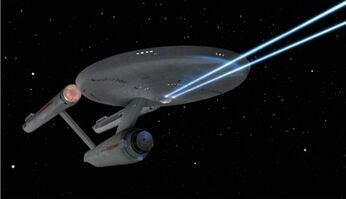
Phasers!
It has been proclaimed that these weapons were an upgraded version of the "phase cannons" utilized by Starfleet a century earlier and the term "laser" was simply a slang terminology.
In the early 2260s, the Enterprise underwent a refit that upgraded these weapons with phasers; an acronym derived from the term "PHASed Energy Rectification". Phasers possessed far greater destructive power, selectivity, range, and tunability than its predecessor weapons. It could generate beams capable of stunning living beings within the range of entire blocks or killing them; superheat matter or function as a drilling or cutting tool; and disintegrate matter.
The Enterprise contained several phaser banks with a range of 90,000 kilometers and located in different locations; forward, aft, starboard, port, and midships to cover a broad range of firing arcs.
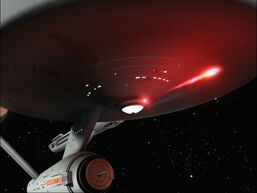
Photon Torpedo Away!
The Enterprise was also armed with 6 photon torpedo tubes; which was also the only weapons that it was capable of using at warp speed velocities. Consisting of a warp engine attached to a casing containing both matter and anti-matter; photon torpedoes had a simple trigger that would allow the anti-matter and matter to come into contact and violently explode. Photon torpedoes had an approximate range of 300,000 kilometers.
Special Features
Like all Federation starships, the USS Enterprise was outfitted with a security prefix code. Individually assigned to each starship, this unique code was only accessible to Starfleet officers of a certain rank. If a Federation starship turned rogue or had been captured by hostile forces, it was possible to transmit the prefix code and remotely assume control over the various systems of the starship including weapons and shields, disabling them.
Due to the highly classified technologies and information aboard the USS Enterprise, it was deemed necessary that the crew might be forced to deny hostile forces the ability to study it or access the restricted information in the starship's information banks. For that reason, the Enterprise incorporated a series of auto-destruct sequences and methods to destroy the ship.
The primary method was the deliberate shut down of all magnetic forcefields around the anti-matter supplies held in storage and in the main reactor itself. This would cause the uncontrollable contact of matter and anti-matter and would guarantee the violent annihilation of the entire ship within 30 seconds. The secondary method would be the ignition of special demolition packs scattered throughout the structure of the ship itself and a deliberate overload of all of the electrical system leaving the ship a irreparable and unsalvagable hulk. This second method was used in the event that the starship was in close proximity to ally forces or planetary bodies.
Aboard the Enterprise, it was required that the Captain and at least two senior officers give verbal orders and confirmations of those orders to set the auto-destruct sequence and only they could give the abort code as well. It was possible to also abort the sequence if necessary up until the last five seconds.
The USS Enterprise was also equipped with the capability to separate the two main sections of the hull; the saucer section and the engineering section in an emergency. If an catastrophic emergency was confined to the engineering sections or the warp nacelles, it was possible to evacuate to the saucer section and then to jettison from the "neck" via explosive bolts.
As the saucer section contained the impulse engines, it would be possible for the saucer section to maneuver to a limited degree and have limited power for life support and use the saucer as a life boat and preserve as much of the crew as possible.
This procedure became considered a standard emergency capability in future Starfleet vessels although it was only rarely utilized. The original Enterprise itself, never availed itself of this emergency procedure.
History
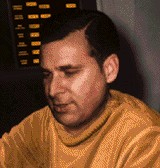
Robert April
Designed and commissioned by Starfleet; the NCC-1700 and her sister starship, the NCC-1701 began construction in 2243. The various components were created at the San Francisco Naval Yards before being shipped into orbit where they were assembled under the oversight of Captain Robert April.
April commandeered the as-of-yet unfinished and unnamed ship on a priority and unauthorized rescue mission near the Romulan Neutral Zone which was successfully completed thanks to the distinguished service of a security officer, George Kirk Sr. (and father of James T. Kirk). Subsequently, George Kirk would suggest to April that the unnamed ship to be named 'Enterprise'. In 2245 when the ship was completed; the NCC-1701 was christened the USS Enterprise while her sister ship, the NCC-1700 was designated the USS Constitution, becoming the lead ship of their starship class.

Christopher Pike
April would continue to serve as the ship's captain during its trial runs, shakedown cruise, and several early short-term missions before he was promoted to Commodore, passing command to Captain Christopher Pike.
Pike commanded the Enterprise from 2251 to 2262 and was responsible for heading two separate 5-year missions which saw distinguished scientific explorations in Rigel, Vega, and the Talos Systems. One of the most famous Starfleet officers, the half-human and half-Vulcan hybrid Spock served under Pike for 11 years, first as Science Officer before being promoted to his First Officer; a post he would continue under the next Captain of the Enterprise as well.

James T. Kirk
In 2264, James T. Kirk became the youngest Captain in the history of Starfleet and was simultaneously bestowed command of the already highly distinguished USS Enterprise. Kirk's legendary 5-year exploration cruise from 2265 to 2270 was also the most famous of the Enterprise's exploratory missions; setting new groundbreaking records of encounters with strange new life forms and new fantastic discoveries of alien civilizations. Even a century later, Kirk's 5-year mission logs remains required reading by aspiring Starfleet cadets and his record of First Contact alien encounters was unmatched until Captain Kathryn Janeway of the USS Voyager was flung over 70,000 light years into the Delta Quadrant a century later.
The Enteprise was the first Federation vessel to travel and survive an encounter with the Galactic Barrier; visited over seventy different worlds and made first contact with over sixty different alien races and species including the Gorn, the Horta, and the First Federation; encountered noncorporeal entities such as Trelane, the Thasians, the Organians, Gorgon, and the Zetarians; broke the Warp 9 Factor Barrier and time traveled on two separate occasions by accident; and encountered an alien entity that had once been worshiped on Earth as the Greek deity Apollo as well as the genetically augmented tyrant Khan Noonien Singh from the Eugenics Wars.
The Enterprise also had several hostile encounters with the Klingons, the Romulans, the Orions, and the Tholians as well as neutralizing several dangerous entities and creatures such as Redjac, the Dikironium Cloud Creature, the Space Amobea, and the Doomsday Machine.
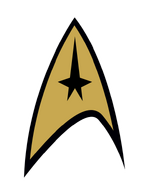
Enterprise Delta Insignia
Upon the successful completion of his 5-year mission in 2270, Kirk was subsequently promoted to the Admiralty. In addition, the Admiralty of Starfleet decided to specially honor the now iconic starship which had come to represent the "best and brightest of Starfleet" to not only the general public of the Federation but all of the various governments and star nations.
Up until this point, the various ships and posting stations of Starfleet all bore their own separate and unique assignment patches and badges; including the USS Enterprise. In 2270 by Admiralty decree; the insignia of Starfleet would now be represented by the Enterprise's unique delta symbol and encompass all of the different branches and divisions of Starfleet.

Willard Decker
The aging Enterprise itself would undergo a major and badly needed overhaul. The ship had been subjected to major structural stresses unlike any other starship of her class from hull pounding battles to frame stressing enormous warp velocities that it had never been intended to sustain. In addition, Starfleet had made several innovative and qualitative improvements to their technology and were eager to upgrade the Enterprise to being once more on he cutting edge of scientific exploration and defense.
The Enterprise would undergo a 3 year refitting and upgrade under the direction of Captain Willard Decker. The Enterprise was practically rebuilt from the keel up with an expanded saucer section and engineering section as well as a brand new warp core and warp nacelles enabled it to attain greater warp velocities. In addition every single system from the main sensor dish, the phasers and photon torpedo launchers, the transporter rooms, and sickbay was significantly upgraded. Technically, very little of the internal structures of the old ship was retained. Although Decker was intended to serve as the Enterprise's new captain on her next deployment, the sudden appearance of the V'Ger Probe resulted in Starfleet Admiralty to make a last minute personnel change in 2273.
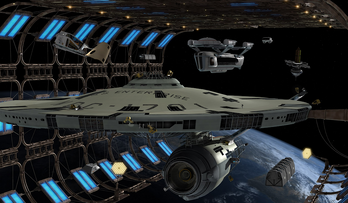
Rebuilding a Better Enterprise
Due to his vaster experience in first contact situations and tactical operations, Admiral James T. Kirk was reassigned to captain the Enterprise on its mission to make peaceful first contact with the V'Ger. Decker was demoted to Executive Officer under protest, bitterly convinced that Kirk had exploited the situation in order for him to once more captain the Enterprise. Nevertheless, Decker sacrificed his life to merge with V'Ger in order to prevent it from destroying Earth and was apparently transformed into a new life form. To honor him, Kirk decided to list Decker as "missing in action".
All of the future Constitution-Class Starships would be based upon the Enterprise's extensive refit design which has led to some dubbing it "The Enterprise-Class" as a variant or a sub-class of the Constitution-Class.
After a shakedown cruise of its new technologies, the Enterprise was placed under command of now promoted Captain Spock. In 2285, the Enterprise was being used for an extended training cruise for Starfleet cadets with Admiral Kirk observing onboard. However, Khan Noonein Singh managed to hijack the USS Reliant and escaped his exile on Ceti Alpha V.
He subsequently stole the classified Genesis Device from the Regula I Space Station in order to lure Kirk to him. Tasked by Starfleet to investigate, Kirk assumed command of the Enterprise and shortly afterwards discovered the Reliant which faked being in distress. Luring the Enterprise in, Khan critically damaged the unaware and unshielded starship. However, Kirk turned the tables on him by using the prefix codes to remotely disable the Reliant's defenses and counterattacks, temporarily disabling the Reliant and allowing the Enterprise to limp away and rescue the survivors aboard the Regula I.
Recovering, Khan quickly tried to pursue the still critically damaged Enterprise into the nearby Mutara Nebula which scrambles both shields and sensors; leaving both ships evenly matched. Kirk quickly overwhelms Khan due to his superior knowledge of space tactics and cripples the Reliant. However an enraged Khan triggers the Genesis Device, intent on destroying Kirk who is unable to escape the Mutara Nebula with the still offline warp drive. However Captain Spock sacrifices his life to repair the warp drive and inadvertently exposes himself to enormous radiation levels in the process. The detonating Genesis Device creates a new life bearing planet out of the Mutara Nebula and a saddened crew decide to launch Spock's body inside a torpedo casing into orbit around the new planet.
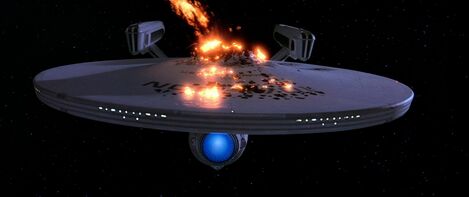
End of an Era
Upon returning to Earth, it is determined that the Enterprise is simply too old to be worth the expense of being repaired and is slated for decommissioning. At the behest of Spock's father, Ambassador Sarek; Kirk decides to return to the Genesis Planet in order to retrieve Spock's body so that his friend can be put to rest.
However Kirk is blocked by Starfleet Command and realizing that time is of the essence, conspires to steal the Enterprise with his core crew members to travel to Genesis. But Klingon Commander Kruge seeks the secrets of Genesis and without a full crew and still suffering from battle damage, the Enterprise is simply no match for his Klingon Bird-of-Prey. To prevent the ship from falling into Klingon hands, Kirk activates the self-destruct sequence on a timed delay while he and the crew escape to Genesis. Demolition charges ignite, causing the veteran starship to explode in a blaze of glory; killing the Klingon boarding party.
-

James T. Kirk (Star Trek Alternate Reality) -

Star Trek (1966) -

Star Trek III: The Search for Spock (1984) -

Star Trek (2009) -

Star Trek Into Darkness (2013) -

James T. Kirk (Star Trek TOS) -

Star Trek: The Animated Series (1973) -

Leonard McCoy (Star Trek TOS)
All items (54)
- Saavik (Star Trek TOS)
- Spock (Star Trek Alternate Reality)
- Spock (Star Trek TOS)
- Star Trek (1966)
- Star Trek (2009)
- Star Trek II: The Wrath of Khan (1982)
- Star Trek III: The Search for Spock (1984)
- Star Trek Into Darkness (2013)
- Star Trek: Discovery (2017)
- Star Trek: Strange New Worlds (2022)
- Star Trek: The Animated Series (1973)
- Star Trek: The Motion Picture (1979)


